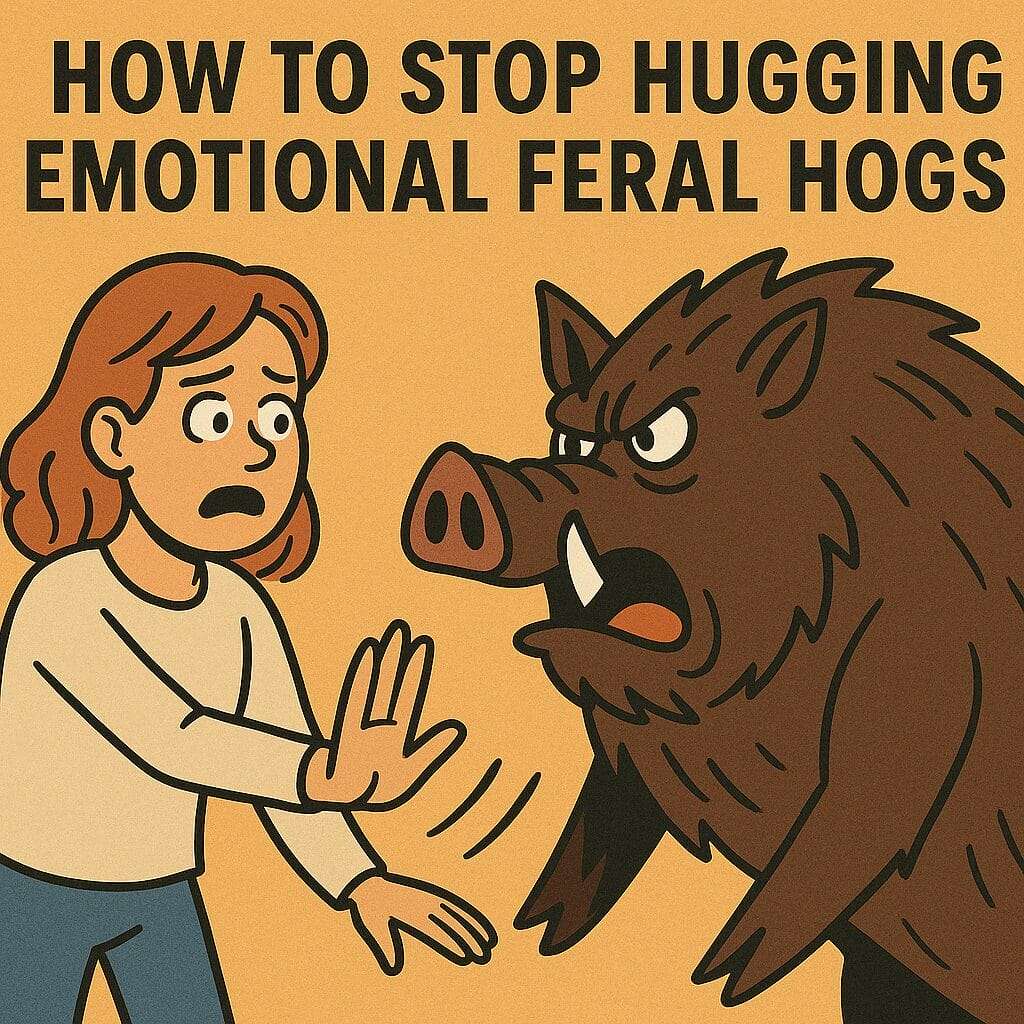
How to Recognize Character Flaws (Before They Hijack Your Peace)
You can’t hug a feral hog and expect it to purr.
That’s what my husband said—completely deadpan—after I told him about a man who’s made one too many “just slightly too close” overtures toward me over the years.
Not overtly gross. Not technically inappropriate.
Just that unnerving vibe.
The kind where someone memorizes your coffee order and gait pattern…
…but acts like you’re strangers in public.
Where every interaction feels like a chess game you didn’t know you were playing.
It’s polite. But your skin still crawls.

When I told my husband, he didn’t get jealous. He got grounded.
“This parking spot is occupied,” he said.
“Tell him to find another one.”
And then—without blinking:
“You can’t hug a feral hog and expect it to purr.”
Reader, I laughed.
And then I realized—that line? It’s spiritual.
Because that’s exactly what so many of us do.
We smile at dysfunction.
We rationalize red flags.
We try to soothe chaos with kindness.
And then we’re shocked when we end up emotionally mauled.
If you’ve ever been confused by someone’s behavior, doubted your gut, or questioned your standards—this piece is for you.
Your Guide to Sanity Without Drama
What Is Character—Really?
Before you can recognize a character flaw, you have to understand what character really is.
It’s not just about being nice, agreeable, or having good intentions.

It’s about how someone shows up when life gets hard—when they’re under pressure, when they face limits, when they don’t get what they want.
Dr. John Townsend puts it this way: character is “the set of abilities we need to meet the demands of reality.”
That includes how we handle feedback, conflict, and loss—not just how polished we appear on the surface.
And here’s the part most people miss: character is shaped.
It’s not just something you’re born with. It’s formed over time—through repetition, role models, and what gets rewarded in our environments.
-
In families, you might be praised for people-pleasing, lying to keep the peace, or pretending you’re “fine.”
-
In business, you might be applauded for over-functioning, avoiding conflict, or emotionally checking out.
So we grow up calling emotional detachment “professionalism.”
We mistake manipulation for “savvy.”
We interpret chronic conflict-avoidance as “being easygoing.”
But real character? It’s not about how good you look on paper.
It’s about how you treat people when things don’t go your way—and when no one’s watching.
…let’s bridge into how those habits get formed—and how people with deep flaws didn’t become that way by accident.
How Character Gets Formed—Or Fractured
No one wakes up one day and suddenly starts gaslighting people, ghosting accountability, or steamrolling boundaries.
Character—and character flaws—are both learned.
They’re shaped by what we survived, what we were praised for, and what we were taught to ignore.
In Protecting Your Mental Well-Being: Dealing with Emotional Abuse, I wrote:
“We were often taught to stay connected to people who made us feel inferior, useless, or unworthy—because they were ‘family.’
Unless you have a high sense of worth, an emotionally toxic person can make you feel so bad about yourself, you’d rather isolate than be around anyone else.”
That’s how character flaws are passed down.
Just like strengths, they’re conditioned—through trauma, culture, upbringing, and survival instincts.
And often? We don’t see the flaws because we’re too focused on the good side. And of course, it felt good. This is when we think about how they:
- Made us laugh.
- Talked about “our potential.”
- Quieted the parts of us we were afraid to face alone.
So when the bad stuff shows up—like throwing a rock through your windshield, stealing your clients, or calling your mother to tell her you’re a monster—you feel emotionally ambushed.
“Wait—what just happened?”
Or maybe it wasn’t even dramatic. Maybe it was a slow, subtle burn.
A weird comment here. A boundary push there.
And by the time you finally distanced yourself, you’re looking back thinking:
“Snap. This brew of cray-cray was simmering for a minute.”
So if you’ve ever caught yourself making excuses for someone who lies, manipulates, or guilt-trips you…
That’s not weakness.
That’s conditioning.
No one taught you the difference between emotional struggle and emotional abuse.
You’re learning now. That’s what matters.
What a Character Flaw Isn’t
Let’s be clear:
A character flaw is not…

- Being introverted
- Being “bad at texting”
- Having emotional baggage or a messy past
We all have mess. That’s not the issue.
Struggling doesn’t make you flawed. It makes you human. The difference is whether you’re willing to take responsibility and grow—or not.
What a Character Flaw Is
A character flaw is a repeated pattern of:

- Refusing accountability
- Blaming others
- Manipulating outcomes
- Disrespecting boundaries
- Expecting access without offering responsibility
But it doesn’t stop there.
Other signs include deception, emotional unavailability, control issues, chronic excuse-making, entitlement, irresponsibility, self-absorption, and yes—narcissism.
These traits don’t just show up one day.
They form over years—reinforced, ignored, and repeated until they become a person’s default operating system.
Wounded doesn’t mean dangerous.
But when someone refuses to examine how their pain impacts others?
That’s where the harm creeps in.
Discomfort doesn’t always come with sirens. It often slips in through subtle interactions—so here’s what that can look like.

You Don’t Need a Dramatic Story to Justify Discomfort
Let’s say you’ve been loosely collaborating with someone—we’ll call her “Jessica.” She slid into your inbox a few months ago, praising your work and hinting at “mutually beneficial opportunities.”
You weren’t looking for a partnership, but you stayed polite—just the way your mama taught you to behave. You shared your rates and offered clarity.
And then… she ghosted.
Three weeks later, she reappears—this time with a strange edge to her tone.
With a raised eyebrow, she questions your values. Next, she implies your prices are exploitative. Then she has the gall to suggest that your “real issue” is a fear of connection.
No curiosity.
No humility.
Just projection, veiled condescension, and a sprinkle of manipulation.
You don’t need to argue with Jessica.
You don’t need to prove that you’re kind, generous, or open-hearted.
You need to recognize this: you’ve just witnessed a character flaw in action—a small, sour moment that reveals something much deeper.
This is exactly what I unpack in How You Can Quickly Identify a Dangerous Personality:
“Some people say all the right things—but leave you feeling drained. Others cross a line and then make you feel like you’re the problem. The longer you try to make sense of their behavior, the more you get tangled in a dynamic that was never healthy to begin with.”
Jessica may not be boiling rabbits like Fatal Attraction, but the vibe? Still dangerous. Still draining.
Because it’s not about the drama—it’s about the pattern.
Why We Miss the Warning Signs—Even When We’re Smart
Let’s be honest.

We were taught:
“Give people the benefit of the doubt.”
“Don’t judge too quickly.”
“Everyone deserves a second chance.”
Sure. But not at the cost of self-betrayal.
Many of us were raised—through family, culture, religion, or trauma—to interpret harm as a misunderstanding.
To see emotional red flags as something we should just “pray over,” journal through, or give one more chance.
And this doesn’t just show up in romantic relationships.
It happens with friends. Clients. Team members. Even family.
When you’re taught that keeping the peace is more important than naming the truth, you start to doubt your own inner warnings.
How to Stop Hugging Emotional Feral Hogs
If you’ve ever stayed too long in a draining relationship—professional, personal, or otherwise—just hoping they’d change, you’re not alone.
Most of us were conditioned to analyze pain instead of walk away from it.
But here’s the shift: when someone shows you that they can’t handle truth, responsibility, or reciprocity—you don’t need more data. You need distance.
Here’s how you start pulling back from those with deep character flaws (a.k.a. the feral hogs of human interaction):

🛑 Stop overexplaining.
You don’t owe a 3-paragraph disclaimer about your boundary.
You don’t need to soften your truth so someone else can feel better about ignoring it.
🧠 Stop hoping they’ll “come around.”
If they’re not curious now, they won’t magically become curious later.
Hope is beautiful. But when you tie it to someone else’s emotional maturity, it becomes a trap.
🩺 Start noticing how you feel after every interaction.
Not what they said. Not what you hope they meant.
Just—how did your body feel afterward?
Did your shoulders tense?
Feel your stomach make a belly flop?
Walk away spinning in self-doubt?
That’s wisdom. Not weakness.
🔮 Start honoring discomfort as a form of divine intelligence.
Discomfort isn’t always trauma. Sometimes, it’s your nervous system whispering, “This isn’t safe. This isn’t mutual. This isn’t right.”
The sooner you listen, the sooner you stop betraying yourself for the sake of harmony.
My rule now is simple:
If your presence brings me confusion, anxiety, or exhaustion—
I don’t need a backstory.
I need space.
Let them think you’re cold.
Let them call you dramatic—without clapping 👏 back 👏 on social media.
Yes, let them “misunderstand” you.
Your nervous system doesn’t owe anyone a press release.
🔍 The Mirror Moment: What Drew You In—and Why It Matters
This is the unsexy part.
The unfunny part.
The part where you take a breath, get real, and admit: “I was drawn to this person for a reason.”
Because here’s the deal:
People with deep character flaws don’t just appear.
They’re not random. They don’t sneak in.
You and this person found each other—and even if it wasn’t romantic, there was a pull. A pattern. A story.
It’s not about blame.
It’s about getting curious enough to stop repeating the same pain with different faces.
The more you seek reality, the more you’ll see the patterns that keep you from feeling stuck, scared, or hopeless.
So let’s ask the harder questions. Not from shame—but from clarity.
(And yes, some of these were inspired by John Townsend’s Beyond Boundaries, but I’m putting them in my own no-fluff language.)
✏️ Journal Prompts to Help You Connect the Dots:

What drew me to this person in the first place?
What did I think they had that I needed?
When did I first notice something was off?
How did I justify or downplay the red flags?
What price did I pay for minimizing their character flaws?
Did anyone try to warn me? If so, how did I respond?
These aren’t gotcha questions.
They’re flashlight questions.
They help you see what was hidden—so next time, you don’t walk in the dark.
Final Thoughts: Recognize. Release. Reclaim.
You’re not cruel for noticing the pattern.
You’re not dramatic for walking away.
You’re not cold for choosing peace over chaos.
Some people will make you feel like recognizing a character flaw is judgmental.
But it’s not.
It’s leadership.
Because when someone repeatedly dodges accountability, crosses your boundaries, or manipulates your goodwill—that’s not your failure to love them better.
That’s their refusal to grow.
And the longer you try to manage their dysfunction with kindness, the more you’ll question your own clarity.
So here’s your permission:
You don’t need to fix, explain, or justify anymore.
If someone consistently brings you stress, dread, or second-guessing…
You don’t need a backstory.
You need space.
And no, you don’t have to clap back.
Let them misunderstand you.
Let them call you guarded. Cold. Too much.
Because what they’re really saying is:
“You stopped letting me use you.”
Good.
Keep going.
Ready to Go Deeper?
If this resonates, here are a few ways we can stay connected:
🎙️ Listen to the podcast – for honest conversations on healing, leadership, and emotional sobriety.
💌 Write me a note – if something in this article hit home and you want to talk it through.
🤝 Explore working together – if you’re ready to deepen your leadership and healing journey.
You’re not alone in this. And you don’t have to fake your way through it.





